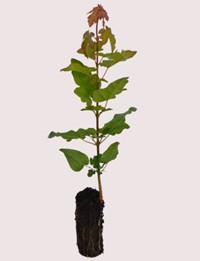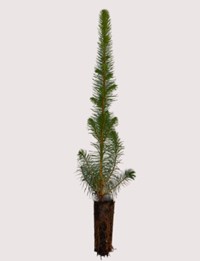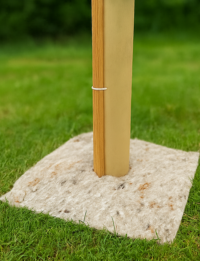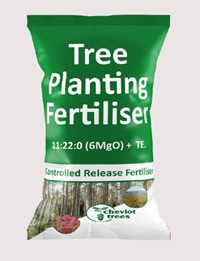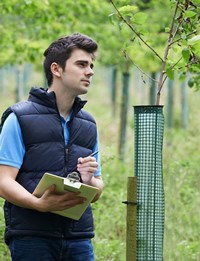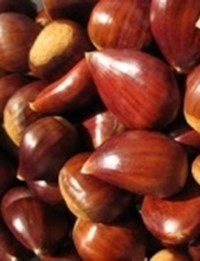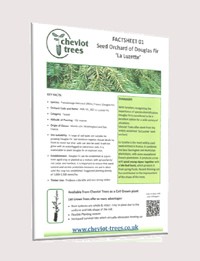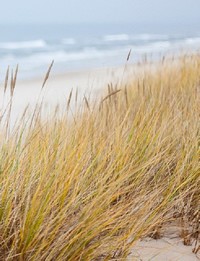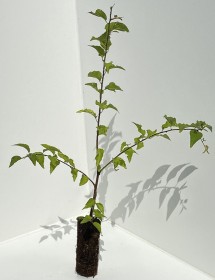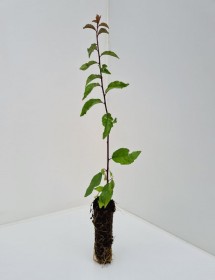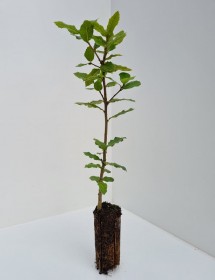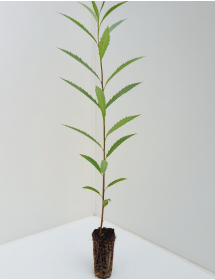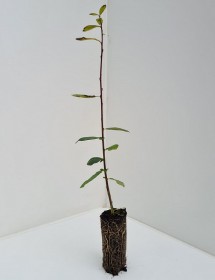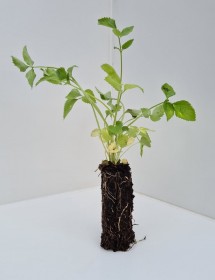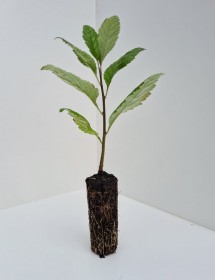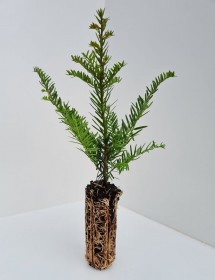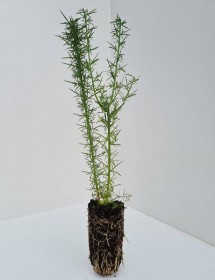
Cell Grown Plants
Every year our nursery in the Scottish Borders produces millions of cell grown broadleaves, conifers, shrubs, hedging plants and a range of other species for environmental planting. Our species range is extensive and we have species to suit all planting objectives.
Cell grown plants can be planted almost all year round and offer excellent survivability as they are supplied with a complete and intact fibrous root system.
Active filters
- Availability: In stock
-
Prunus cerasifera - Cherry Plum
£1.70from £0.74Prunus cerasifera - Cherry Plum is a fast growing, dense hedging plant which is an excellent choice for providing shelter.
Masses of pure white flowers smother the branches in early March before the leaves appear and these are followed in autumn by tasty red or yellow, spherical cherry-plums. You can make jam, wines or even liqueurs from the fruits and it forms a very dense hedge of thorny twigs making it an extremely effective barrier.
The Cherry Plum is an excellent attractant and nectar source for bees and other beneficial insects.
Ultimate height 25 feet (7.5 metres). Can be trimmed to any height above 4 feet (120 cm). Average annual growth rate 1 - 2 feet (45 - 60 cm).
-
Populus tremula - UK Aspen
£1.82from £0.81Populus tremula - Aspen is a beautiful large fast growing tree which is native to the UK and the cooler regions of the northern hemisphere. It is characterised by its trembling and shimmering foliage.
Deciduous. Aspen is a very useful tree species which helps to stabilise soils, mitigate pollution plus it has a high ecological value for numerous insects and fungi. Aspen is a valuable and well regarded timber crop in Scandinavia for firewood, plywood manufacture and paper production.
We grow aspen from two different sources; a UK seed source and also a specific Scottish clonal collection. The latter option is more expensive than the generic UK source due to significantly higher propagation costs but it enables us to offer a reliable supply of plants from a Scottish origin.
-
Prunus avium - Wild Cherry
£1.93from £0.93Prunus avium - Wild Cherry is an attractive species not only aesthetically but also in commercial terms. The timber from Wild Cherry is highly valued in Europe with the top quality pieces destined for the veneer industry.
A large deciduous tree that requires plenty of space. Expect all year round interest with Wild Cherry. It has deep reddish brown shiny bark and the new bright green toothed leaves appear simultaneously with the long lasting clusters of white flowers. Once pollinated the flowers develop into globular shiny, deep red cherries. The leaves turn gold through to red in the Autumn to provide a spectacular show.
We produce this species from multiple seed sources including an Improved seed source. The breeding work to produce the Improved seed was carried out by the Future Trees Trust.
-
Prunus lusitanica - Portuguese Laurel
£2.13from £1.03Prunus lusitanica - Portuguese Laurel has all the desirable properties of Cherry Laurel but has a smaller, pointed leaf.
Fast growing, tolerant and easy to grow it is a superb choice if you need a solid screen. It responds well to clipping and if desired, it is possible to achieve a very tight, formal hedge, more so than the Cherry Laurel - Prunus laurocerasus.
It does produce flowers and berries although these are quite insignificant as the main attraction is the large, dark green glossy leaves.
Its good tolerance of shade also makes it suitable for planting in open areas of woodland or on edges if shelter or cover is required.
3 plants per linear metre in a single row is normally sufficient to create a dense screen in time.
-
Prunus padus - Bird Cherry
£1.92from £0.93Prunus padus - Bird Cherry is native to the UK and we tend to associate it with the northern part of the UK.
Tough and resilient with lots of value for wildlife and it provides an excellent show in the Spring in the Autumn.
Deciduous. Green leaves more oval like in shape than Wild Cherry turning yellow and orange in Autumn.
Almond scented stalks of blossom in the Spring which provide a good early nectar and pollen source for bees. Once pollinated, the flowers develop into reddish brown cherries with a bitter taste which are stripped from the trees by birds.
-
Prunus spinosa - Blackthorn
£1.52from £0.67Prunus spinosa - Blackthorn is widely used throughout the UK for good reasons; robust, useful and tolerant. Commonly used to form impenetrable hedging or as a stand alone large shrub/thicket.
The snow white flowers on Blackthorn mark the start of early Spring and appear before the leaves which are green and narrow in shape.
Once pollinated by insects the flowers develop into small dark fruits.
Blackthorn has long spikes and is densely branched - an ideal location for bird nesting.
Our cell grown Blackthorn plants are often used for hedge planting either on their own or mixed with other species such as Crab Apple, Hawthorn, Dog rose etc. at a planting density of 6 plants per metre.
-
Pseudotsuga menziesii - Douglas Fir
£1.60from £0.70Pseudotsuga menziesii - Douglas Fir is an evergreen conifer that was named after David Douglas who sent the first seed back from North America to Britain in 1827.
It has soft green needles with two grey bands underneath. Oval shaped cones hang and the bark is an attractive reddish brown colour.
One of the most important timber species in the world and widely planted in the UK, Douglas Fir is fast growing and the timber is strong and durable with few knots.
-
Pyrus communis - Wild Pear
£1.62from £0.70Pyrus communis (Wild Pear) is a long lived small to medium sized tree with a columnar habit. It has been cultivated in the UK since 995AD.
This species offers so much; not only from a visual perspective but it is also an important food source for birds and insects.
Deciduous, glossy green leaves which put on a colour spectacle in the Autumn turning orange and red. Mildly thorny stems and it is covered in white blossom in early Spring followed by small pears in Autumn.
A useful addition to a woodland or for inclusion as part of a hedging mixture.
-
Quercus ilex - Holm Oak
£3.34from £1.47Quercus Ilex - Holm Oak is an evergreen tree which is offers all year round colour. A good parkland tree and also useful for hedging or screening.
Whilst not native to the UK it still supports plenty of wildlife and is a great source of winter shelter for birdlife.
Oval dark green leaves which tend to be spiny, almost holly like when they are young. Elongated yellow catkins are produced in the summer which once pollinated by wind develop into acorns.
-
Quercus petraea - Sessile Oak
£1.75from £0.85Quercus petraea - Sessile Oak is similar to English Oak although it prefers wetter upland areas. One of the most economically and ecologically important trees species in Europe.
Sessile Oak is a large deciduous tree with a broad spreading crown.
The stalked leaves have 4-5 deep lobes and stalkless acorns.
Sessile Oak is long lived so it makes a great choice for avenues and specimen tree planting.
-
Quercus robur - Pedunculate Oak
£1.75from £0.85Quercus robur - Pedunculate Oak is an iconic species that supports more life than any other tree species in the UK. One of the most economically and ecologically important trees species in Europe.
Pedunculate (or English) Oak is a large deciduous tree with a broad spreading crown. The stalkless leaves have 4-5 deep lobes and the acorns grow on stalks or ‘peduncules’, hence the name.
Pedunculate Oak prefers lowland areas whereas Sessile Oak prefers wetter upland areas.
To protect and aid establishment of Pedunculate Oak you may wish to consider Tubex Combitube which is a ventilated shelter that provides an open, airy environment for producing Oak.
-
Quercus rubra - Red Oak
£2.03Quercus rubra -Red Oak; its claim to fame is its fiery Autumn foliage colour. Native to North America but widely planted in the UK since its introduction in the 1700’s. The timber has less value than its native cousin’s but it is still an aesthetically pleasing firewood crop or it can be used as a parkland tree.
The leaves are similar in shape and size to the native Oaks but they are more pointed and spiked in appearance.
A fast growing species with a strong central leader. Red Oak doesn’t support as many species of wildlife as our native Oaks but it is still a popular choice with nesting birds and pollinators.
-
Rhamanus cathartica - Purging Buckthorn
£1.93from £0.93Rhamanus cathartica – Purging Buckthorn is a native small tree / large dense shrub with grey-brown bark and spiny branches.
Flowers are yellow green with four petals and are pollinated by insects. After pollination, the female flowers develop into black berries
Useful for woodland planting or hedging. The leaves of Purging Buckthorn are an important food source for tiger moth larvae and caterpillars of the Brimstone butterfly.
-
Rhamnus frangula - Alder Buckthorn
£1.93from £0.93Rhamanus frangula – Alder Buckthorn is a native small tree / large dense shrub
The outer bark is dark brown and unlike the Purging Buckthorn, the branches and stems are smooth and thornless. Star shaped flowers in the Spring with red berries following which then mature / darken to almost black in the Autumn.
Native to the UK and grows best in damp, acidic soils and open woods.
Useful for woodland planting or hedging. The leaves of Alder Buckthorn are an important food source for tiger moth larvae and caterpillars of the Brimstone butterfly.
-
Rosa canina - Dog Rose (Pink)
£1.52from £0.67Rosa canina - Dog Rose is the only native Rose that we produce, and it is the most widely used as it is easy to grow and is adaptable to most locations.
Ideal for planting as part of a native mixture or on its own.
Deciduous with small green toothed leaves. Large and sweetly scented white or pink flowers appear in summer with red oval berry like hips forming in small clusters.
Dog Rose is a good choice for wildlife, offering protective shelter and habitat plus a good source of nectar for insects. Bird species such as blackbirds, redwings and waxwings eat the hips.
-
Rosa rugosa Alba - Ramanas Rose (White)
£1.93from £0.93Rosa rugosa Alba - Ramanas Rose is a large robust shrub that produces large, beautiful and very fragrant bowl shaped flower that are silky white. It flowers earlier than our native Dog Rose and often repeat flowers during the Spring and Summer. Very large, red hips follow the flowers.
The stems are covered in small spines which makes it ideal for an impenetrable and dense hedge or barrier.
A good all rounder. Attractive, good disease resistance, fast growing and very tolerant of exposure and coastal locations.
We also produce Rosa rugosa which has fuchsia pink flowers.
-
Salix alba - White Willow
£1.75from £0.85White Willow is a fast-growing, large deciduous tree with a graceful, rounded crown. Its name comes from the striking white undersides of its narrow leaves, which shimmer silver in the breeze. As a native to the UK it is often found in wet habitats like riverbanks, marshes, and damp woodlands, where it plays a vital role in stabilizing soil and preventing erosion.
This species is prized for its flexibility and resilience. Historically, its branches have been used for basket weaving and crafting. It's an excellent choice for wetland restoration projects or for creating a beautiful, naturalistic landscape near water features. White Willow provides a valuable habitat for many insects and birds and is an early source of nectar for pollinators in the spring.
-
Salix aurita - Eared Willow
£1.52from £0.67Salix aurita - Eared Willow is more shrub like than tree, growing only to around 2.5m height. Commonly found as part of a montane scrub community but also within damp woods or on heathland. Very tolerant of exposure.
It is native to most of Europe but most commonly found throughout the West of Scotland and as far north as Shetland. Deciduous with small crinkled green leaves that are slightly hairy especially the underside of the leaf. Named the eared willow due to persistent stipules which are at the base of the leaf stalk.
-
Salix caprea - Goat Willow
£1.52from £0.67Salix caprea -Goat Willow is a small, native deciduous tree which has a wide range throughout the UK. Commonly known as the Pussy willow as the male catkins have the appearance of a cats paw.
Goat willow is a very valuable species. Useful as a windbreak or shelterbelt plus good for preventing soil erosion. It has a taller eventual height than Grey willow.
This species is one of our first native trees to flower in the spring and it provides a high quantity of quality pollen and nectar food source to insects and birds such as the difficult to find regal purple emperor butterfly.
-
Salix cinerea - Grey Willow
£1.52from £0.67Salix cinerea - Grey willow or sallow is a small, native deciduous tree with an eventual height taller than Eared willow but shorter than Goat willow. Common across much of the UK often growing in wet habitats. It is a very tough species and thrives on poor, neglected ground.
Deciduous with oval like green leaves and silky grey catkins that appear in January and turn yellow in March.
As with most willow, it has a very high ecological value and provides a valuable source of nectar for bees and birds.
-
Salix fragilis - Crack Willow
£1.75from £0.85Salix fragilis - Crack Willow is a deciduous medium sized tree which is native to the UK. Very robust and fast growing.
Glossy, dark green lanceolate leaves with yellow/green catkins which later turn brown. Grows on most soils and is ideally suited to damp areas such as water margins, and the edges of marsh areas.
Crack willow has a strong value for wildlife. The catkins provide an important source of early pollen and nectar for bees and other insects. Caterpillars of a number of moth species feed on the foliage and the branches make good nesting and roosting sites for birds.
-
Salix viminalis - Common Osier
£1.82from £0.81Salix viminalis - Common Osier is very large shrub or a small tree. Extremely fast growing in damp soil so good for producing fast growing woody biomass or to produce a loose windbreak or large screen.
It is deciduous with long slender green leaves that appear after the flowers. Functional for many purposes including biomass, willow weaving and coppice wood plus it is a good source of food and shelter for wildlife. Very easy to grow!
-
Sambucus nigra - Elder
£1.82from £0.81Sambucus nigra - Elder is a large, fast growing native species that is best planted as a woodland shrub. It is often found in hedgerows but it is often too thuggish for this purpose.
Green, pinnate leaves with oval and toothed leaflets.
The flowers are the main attraction with Elder; they are large and flat in a cluster like form, cream in colour and are highly scented. They provide nectar for insects and the base for a quintessentially British cordial!
After the flowers are pollinated by insects each flower develops into a small purplish black berry which ripens from late summer and are eaten by small mammals.
-
Sorbus aucuparia - Rowan
£1.52from £0.67Sorbus aucuparia - Rowan is commonly referred to as Mountain Ash due to its ability to grow in high altitude locations. A showy native deciduous tree which offers interesting flowers, foliage and fruit.
Rowan has green pinnate leaflets that are long, oval and toothed. Expect a colourful performance in the Autumn with fiery hues of red, orange and yellow.
Clusters of creamy white flowers in summer which once pollinated form bundles of red berries. Both flowers and berries are an indulgent treat for wildlife; the flowers provide pollen and nectar for bees and the berries are good autumn sustenance for birds.
-
Sorbus aria - Whitebeam
£2.13from £1.03Sorbus aria - Whitebeam is a native tree with a compact, domed habit. Ideal for planting as part of a mixed woodland, as a hedgerow tree or in a parkland setting.
The main attraction is its large, rounded thick leaves which are almost white on the underside which then turn a russet brown in the Autumn. Five petalled cream-white flowers appear in clusters in the Spring which then go on to produce scarlet red berries which are often eaten by birds.
-
Sorbus torminalis - Wild Service Tree
£3.34from £1.47Sorbus torminalis - Wild Service Tree is probably one of the rarest native species in our range and is often associated with ancient woodlands. Worth considering as a hedgerow tree.
A medium sized deciduous tree that is often mistaken for a maple due to its leaf shape and interesting autumn colour which turns bright red and copper.
Clusters of white spring flowers which once pollinated form small brown fruits that are enjoyed by birds.
Sometimes called the ’Chequer Tree’ probably due to the chequered pattern on the bark and the Prime Ministers official country home is named after it!
-
Symphoricarpos albus - Snowberry
£1.93from £0.93Symphoricarpos albus - Snowberry is a dense shrub that is fast growing and very tolerant of shade and poor soils.
It is often used for screening and is often favoured by game birds as it provides shelter and security.
Deciduous with light green leaves. Small pink flowers in July that turn to pearl white berries in the Autumn.
-
Taxus baccata - Yew
£1.93from £1.03Native to the UK, Taxus baccata - Yew is a dense evergreen conifer with small green needles.
Used for hundreds of years in the UK to create hedging, the bright green spring growth matures to a dark green for a classical look. It can be easily shaped and makes an excellent screen for privacy.
It is often perceived to be a slow growing species but it is actually quite fast growing in its juvenile stage.
The normal spacing for hedge planting is around 3 plants per linear metre.
-
Thuja plicata - Western Red Cedar
£1.52from £0.67Thuja plicata - Western Red Cedar is a very useful species and a popular choice with our customers. It is a tall, multi-functional evergreen conifer.
It has flat sprays of sweetly scented green foliage with brown, oval shaped cones.
In the UK Western Red Cedar is planted for timber production and also for hedging.
The highly durable redwood timber is well regarded as it contains a natural preservative with helps to resist fungal attack.
Western Red Cedar is an excellent hedging species as it is evergreen, dense and is easier to manage than other conifer species such as leyandii. If planting for hedging the normal planting density is 3 plants per metre.
-
Tilia cordata - Small Leaved Lime
£2.13from £1.03Tilia cordata - Small Leaved Lime is a large and long lived tree which is native to the UK and most of Europe. Well known and widely utilised as a parkland or avenue trees but also frequently planted as a component in a mixed woodland setting.
Deciduous heart shaped leaves which are glossy green on top and paler underneath turning a clear yellow in the Autumn.
In summer, small but very fragrant creamy white flowers are borne in clusters.
-
Tilia platyphyllos - Large Leaved Lime
£2.13from £1.03Tilia platyphyllos - Large Leaved Lime is a large and long lived tree which is native to the UK and most of Europe. Well known and widely utilised as parkland or avenue trees but also frequently planted as a component in a mixed woodland setting.
Deciduous heart shaped leaves which are glossy green on top and paler underneath turning a clear yellow in the Autumn.
The bark of the Large Leaved Lime is darker when compared against Small Leaved Lime. Unlike Small Leaved Lime, Large Leaved Lime does not produce suckers from the base of the trunk.
In summer, small but very fragrant creamy white flowers are borne in clusters.
We also produce Tilia cordata - Small Leaved Lime.
-
Ulex europeaus - Gorse
£1.98from £0.88Ulex europeaus - Gorse is tough, adaptable and very pretty when planted en mass The ‘leaves’ are long sharp spikes that are hostile in appearance.
The vibrant, coconut scented yellow flowers symbolise that spring has arrived and typically appear in April/May.
Many species of birds take full advantage of the dense shelter that gorse provides and the gorse flowers are a great source of nectar for bees and butterflies.
-
Ulmus glabra - Scottish Elm
£2.13from £1.03Ulmus glabra - Scottish Elm has the potential to grow into a large tree and is typically found in Scotland and the West of England. Native to the UK and together with Oak it was once a major tree species in the UK.
It is a very tough species and can withstand low temperatures and high elevations. Deciduous.
Scottish Elm has purplish red flowers that appear before the foliage appears in early Spring. The leaves are similar in appearance to Hornbeam with broad, serrated leaves that turn yellow in the Autumn. Our plants are grown from seed to provide a greater range of genetic diversity.
-
Viburnum opulus - Guelder Rose
£2.13from £1.03Viburnum opulus - Guelder Rose is a large shrub with three lobed leaves which turn orange or red in autumn. Enjoys damp conditions and is often found along riverbanks, but also in hedgerows.
The flowers of Viburnum opulus appear in May through July and produces small clusters of almost translucent red berries in the autumn.

